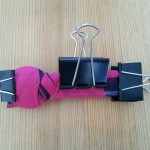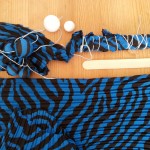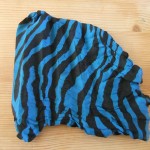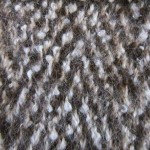Introduction
For this exercise we explore the use of hot and cold water on synthetic fabrics to achieve texturing and shaping. After shaping polyester or similar fabrics around moulds/shapes (buttons, pebbles, etc.) the fabric is boiled for around 30 minutes then plunged in very cold water before being allowed to dry and the mould removed. (After boiling I had to freeze the pieces as they didn’t appear to have got cold enough to hold the shapes!).
The extreme changes in temperature cause the fabric to distort and hold their shape, if not permanently, then semi-permanently. This is similar to a technique used on an industrial scale by one of my research artists, Issey Miyake, who uses extreme heat to set pleats and folds permanently into a range of fabrics.
i) Using hot water – Polyester vest-top, clamps and spoons
- Pr 3: Ex 3 – Fusing – hot water 01
- Pr 3: Ex 3 – Fusing – hot water 02
- Pr 3: Ex 3 – Fusing – hot water 03
For this exercise I used an old polyester vest-top. I cut a section from the top, wrapped a number of metals spoons in the fabric and clamped the fabric around the spoons.
- Pr 3: Ex 3 – Fusing – hot water 04
- Pr 3: Ex 3 – Fusing – hot water 05
- Pr 3: Ex 3 – Fusing – hot water 06
- Pr 3: Ex 3 – Fusing – hot water 07
- Pr 3: Ex 3 – Fusing – hot water 08
- Pr 3: Ex 3 – Fusing – hot water 09
ii) Using hot water – pre-creased polyester shirt – lollipop sticks and polystyrene balls
- Pr 3: Ex 3 – Fusing – hot water 10
- Pr 3: Ex 3 – Fusing – hot water 11
- Pr 3: Ex 3 – Fusing – hot water 12
- Pr 3: Ex 3 – Fusing – hot water 13
- Pr 3: Ex 3 – Fusing – hot water 14
For this exercise I used an old polyester shirt with a bold print that had already been permanently-pleated. I thought it would be interesting to see how the existing pleating would influence the heated moulding. The first piece was wrapped around large lollipop sticks and secured with string. For the second piece polystyrene balls were used to create different-sized moulded shapes in the fabric. The balls were tightly tied into the fabric with string.
- Pr 3: Ex 3 – Fusing – hot water 15
- Pr 3: Ex 3 – Fusing – hot water 16
- Pr 3: Ex 3 – Fusing – hot water 17
- Pr 3: Ex 3 – Fusing – hot water 18
This was the lollipop sticks, rolled tightly into the fabric and tied with string.
- Pr 3: Ex 3 – Fusing – hot water 19
- Pr 3: Ex 3 – Fusing – hot water 20
- Pr 3: Ex 3 – Fusing – hot water 21
- Pr 3: Ex 3 – Fusing – hot water 22
- Pr 3: Ex 3 – Fusing – hot water 23
- Pr 3: Ex 3 – Fusing – hot water 24
And the polystyrene balls, also wrapped with string, seen from the front and reverse.
iii) Using hot water – net curtain, clamping and polystyrene balls
- Pr 3: Ex 3 – Fusing – hot water 25
- Pr 3: Ex 3 – Fusing – hot water 26
- Pr 3: Ex 3 – Fusing – hot water 27
- Pr 3: Ex 3 – Fusing – hot water 28
- Pr 3: Ex 3 – Fusing – hot water 29
For this sample, old net curtain was used which I believe is polyester/acrylic or a poly-cotton blend. The first piece is folded and clamped. The second piece uses the polystyrene balls as before.
- Pr 3: Ex 3 – Fusing – hot water 30
- Pr 3: Ex 3 – Fusing – hot water 31
The clamped net curtain unclamped.
- Pr 3: Ex 3 – Fusing – hot water 32
- Pr 3: Ex 3 – Fusing – hot water 33
And the curtain moulded around the polystyrene ball.
iv) Using hot water – fusing wet felt
- Wetfelt 01
- Wetfelt 02
- Wetfelt 03
As an alternative to the use of synthetic fibres I extended this exercise to using hot water (plus soap and friction) to create a felted piece. I used hand-dyed merino wool to create this piece, inspired by a lavender field.
- Nuno 01
- Nuno 02
- Nuno 03
This piece was made using the nuno felt technique, fusing merino wool onto fine muslin-silk. I fused different hand-dyed fibres and small pieces of metallic thread to add highlights and interest.
- Knit-felt 01
- Knit-felt 02
- Knit-felt 03
- Knit-felt 04
- Knit-felt 05
- Knit-felt 06
- Knit-felt 07
- Knit-felt 08
These final pieces were made from commercial alpaca yarn that was hand-knitted on extra-large needles then put in the washing machine to shrink, harden and fuse into a firm fabric.
Thoughts and conclusions
Overall, I found the results from the boiling water part of this exercise somewhat disappointing. Whether my fabric choices were poor, my moulds not distinctive enough or my techniques incorrect I’m not sure, but I doubt these samples would withstand any long-term use, even if simply mounted as an artwork. Even freezing to see if this “set” the shapes did not appear to improve matters much. Clearly I need to research this further.
The fused felt pieces were more interesting, in particular using textured knitting stitches and seeing how extreme heat would distort these fabrics to create new fabrics.
Notwithstanding the doubts about longevity of the boiled pieces, my thoughts are as follows:
i) Vest top and spoons
On the vest top the wider section from the spoon bowl created an interesting flared effect but the overall result wasn’t as dramatic as I had hoped. I suspect that the bold patterning on the fabric overshadowed the texturing and light/shade effects from the folds.
ii) Polyester pre-pleated shirt lollipop sticks and polystyrene balls
This was the best sample of the three. There was interesting distortion of the stripes in the fabric where the moulds were and the moulded shapes were stronger and more dramatic than in the other samples. The reverse was also interesting, arguably more so than the front. I still have doubts about how long these shapes would hold as the fabric was very soft and loose.
iii) Net curtain polystyrene balls
The fabric did hold the shape although it remained very soft. The ball used was quite large (about 3cm diameter) so it was perhaps unrealistic to expect a sturdy shape. The end result was rather jellyfish-like and I could see this making an interesting technique for underwater-inspired projects!
iv) Felted pieces
The first, lavender piece, was a fairly straightforward intepretation but could be built up to add texture and shape. I would see this as a starting point for a possible future project.
The nuno felt was fun to do and the way the silk distorted during the process gave interesting added texture. Again, this could be further explored using more added materials and perhaps by building up texture. I would also like to explore using this technique around a form to give a 3-d moulded shape.
The knit-felt was interesting. Although the second piece (05-08) was intended to use the right side of the original pattern stitch, zebra stitch, (07 and 08) the reverse is actually more interesting as a means of interpreting natural surfaces, pebbles, cobblestones etc.
Future ideas and inspiration
I would like to research this technique further as I feel it has a lot more to offer than I achieved. After all, it has certainly been a huge success for many designers! Apart from anything, I am keen to understand what went wrong so that if I choose to repeat the exercise I achieve more satisfactory results. Ideas to try include plainer fabrics, different fabrics, longer boiling time, tighter tying, different moulds.
















































